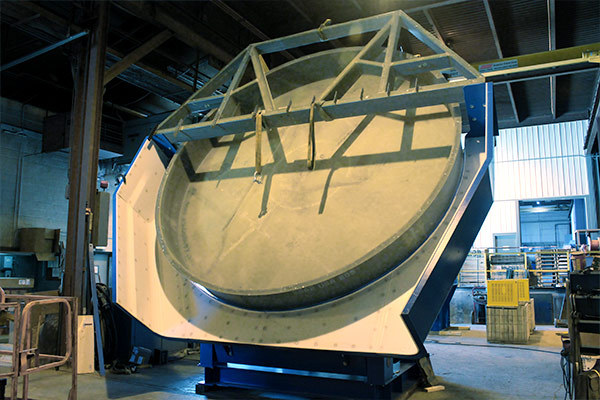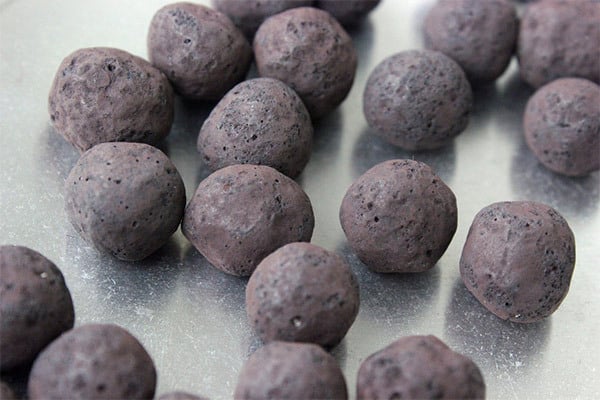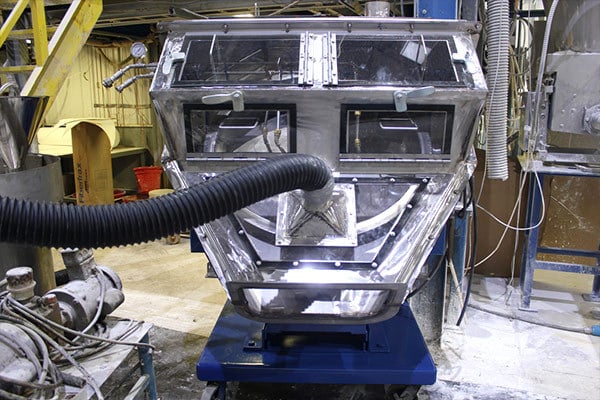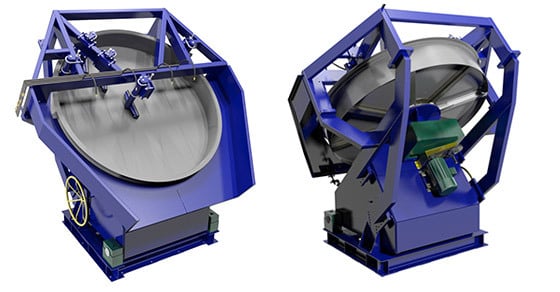Disc pelletizers, also commonly called pan granulators, are a type of agitation (tumble-growth/non-pressure/wet granulation) agglomeration equipment used throughout various industries to pelletize fines into rounded granules.
These diverse pelletizing discs are often selected for the refined granular product they produce, their low recycle rate, and their ability to yield a high level of on-size pellets. Another key reason for which disc pelletizers are chosen is their flexibility in operation; operators can make adjustments on the fly to fine-tune product and keep it consistent during times of fluctuation.
Whatever the reason for selecting a disc pelletizer for a given application, the ability to achieve production goals relies heavily on the proper sizing and design of the pelletizer. Below is an introduction to the principles behind sizing and designing a disc pelletizer that meets its intended application.

FEECO Disc Pelletizer (Pan Granulator)
About Disc Pelletizer (Pan Granulator) Sizing & Design
The sizing and design of a disc pelletizer centers primarily around expected capacity and the characteristics of the material, with several factors coming into play. All of these factors must be considered during both engineering and fabrication in order to construct a unit that will produce the desired granular product at the level of throughput required.
It’s important to recognize that each and every material responds differently to wet granulation, and as such, pelletizers are best engineered around the specific source of material to be agglomerated. FEECO utilizes batch and pilot testing in our Innovation Center to gather the data necessary for pelletizer design and scale-up, and therefore, some of the following statements may be specific to the FEECO International design process.
Pelletizer Sizing Considerations
One of the most common design errors disc pelletizer manufacturers make is under-sizing the disc. Depending on the material being processed, an under-sized disc, while seemingly cost effective, will present one of two problems: it will either not allow operators to reach the necessary throughput, or it will not be capable of producing the desired pellet quality.
In general, commercial-scale pelletizers can be sized to process anywhere from 500 lb./hr to 100TPH, with disc diameter ranging from 3’ to 25’ (0.9 – 7.5m).
To reach an adequate diameter, the sizing process must take three key criteria into consideration:
- Desired Capacity
- Pellet Size
- Preconditioning of materials being processed
Desired Capacity
Disc diameter is largely based on required capacity, or the maximum allowable feed rate a disc can handle while still making pellets that meet certain specifications like pellet size and density.
Maximum allowable feed rate is dependent on many factors, including desired granule size, process recycle rate, how quickly pellets are formed, and more.
Pellet Size
Disc diameter is also a function of the desired pellet size. Disc pelletizers can produce granules in the range of 35 mesh to ¾” (500 microns to 20mm), but in general, the larger the pellets desired, the longer the retention time that will be required to grow the pellet, and the larger the disc diameter must be, though this is best determined through testing.

Iron ore pellets are commonly produced using a disc pelletizer, often referred to a balling disc in this specific application.
Preconditioning
Preconditioning is a preblending step that serves to add a portion of the moisture or liquid binder to the material to be agglomerated on the disc pelletizer. A pin mixer or a pugmill mixer (paddle mixer) may be used to carry out preconditioning and when employed, is placed in series just ahead of the disc pelletizer.
When a preconditioning pin mixer is used, the capacity of the disc can often be increased, allowing for a smaller diameter disc to be utilized. This occurs because the mixer incorporates a portion of the required moisture (binder) content, while also forming seed pellets. Were this to be carried out on the disc alone, a greater retention time would be required. Thus, the use of a preconditioning pin mixer significantly reduces the retention time needed on the pan and allows a smaller diameter disc to process the same amount of material.
In addition, the preconditioning step helps to de-dust the feed material going to the disc pelletizer, reducing fugitive dust issues in the plant.
Material Considerations
In addition to appropriately sizing the disc, the unit must be designed with several factors in mind in order for it to not only meet operational load, but also to maximize production while minimizing wear. Taking into account the following material-specific factors will ensure that the appropriate materials of construction, drive system, and motor are chosen.
Feedstock Bulk Density
Depending on the bulk density of the material, a standard or heavy-duty design may be selected. Standard-duty pelletizers are commonly used for materials like fertilizer and soil amendments, while heavy-duty pelletizers are generally reserved for higher-bulk density materials like iron ore and other heavy minerals.
The primary difference between these two options lies in the reducer; a more robust reducer is necessary for more heavy-duty applications in order to handle the excess weight of the load (an overloaded reducer typically ends in motor or reducer failure, bringing the operation to a standstill).
Similarly, other mechanical components must be selected to withstand the operational load; selecting components that will be underpowered for the job is a sure way to reduce equipment longevity.
Factors of dynamic loading (material landing on the pan; scrapers plowing through the material; fluids being applied; material reactions occurring, etc.) all have to be supported by the power source, the motor, reducer, couplings, hubs, belts, etc. in order to achieve the desired life span of the equipment.
Further, the pelletizer must be designed to do its job not only under normal operating conditions, but also under upset conditions as well. All of these factors must be considered during the design stages.
Material Abrasiveness & Corrosiveness
Whether or not the material exhibits abrasive or corrosive properties will influence the selection of materials of construction.
Disc pelletizers are most commonly constructed of carbon steel, but the potential for abrasion or corrosion may dictate the use of stainless steel. Abrasion-resistant steel or ceramic material is also commonly used on scrapers/plows to minimize wear.
Larger diameter discs are also lined with an expanded metal in order to protect the pan surface from abrasion. In addition to protecting from abrasion, this wear liner also assists in the agglomeration process by helping to maintain a layer of material adhered to the disc, which prevents slipping and provides traction for the material to travel up the disc so that it can cascade down.
Some applications may also demand special materials of construction for other reasons. Producers using the disc for more than one product and concerned with cross contamination, for example, may require that the disc be constructed of a highly polished stainless steel. This is typical in the manufacturing of multiple end products produced in separate runs, such as herbicides and pesticides, where the disc must be quickly and thoroughly cleaned between production runs to mitigate the potential for cross contamination.
Potential for Sticking
A sticky material may be problematic for the disc pelletizer, not only because material must fall into the predetermined moisture range in order to properly agglomerate, but also because a sticky material may promote excess pellet growth or clumping on the pan.
Material must be flowable so that it feeds freely onto the disc; material that is too wet may require additional preconditioning in order to create optimal feedstock for the pan.
For materials that are sticky on reaching the required moisture content, it is useful to line the discharge chute with a reduced-friction surface in order to prevent sticking upon discharge.
Considerations in Pelletizer Customizations
Disc pelletizers are highly customizable. A number of additional components and design adjustments are available to ensure that a pelletizer meets its intended application seamlessly. Common considerations in customization include:
Materials of Construction
While materials of construction must be selected to work with the material being processed, they must also be selected with manufacturing techniques in mind.
Materials must be able to withstand the welding and fabrication process, and as with the mechanical components, must also be selected with operational load in mind; the pelletizer will not only have to handle the material load, but also the load from ancillary components mounted to the equipment, such as the scrapers.
A Note on Fabrication Techniques
Though it might seem obvious, it’s important to recognize that even the best materials of construction provide little value if proper manufacturing techniques aren’t utilized.
Proper fabrication techniques are essential to maintaining disc surface flatness and peripheral roundness when forming and welding components together. Tight tolerance must also be maintained, so that when the various subassemblies are fit together, the unit runs as designed, without any interference.
Dust & Toxicity
Materials that present a dust or toxicity challenge often require the integration of a full or partial hood.
Hoods assist in preventing fugitive dust and emissions from escaping into the surrounding environment. Hoods also have the benefit of helping to reduce the amount of product lost as fugitive dust and therefore may also be used in processing high-value materials.

Hooded FEECO Disc Pelletizer
Scraper/Plow Selection
Selecting the right scraper/plow setup is also important in achieving optimal production on the disc pelletizer.
Proper disc operation relies in part on a thin layer of material on the surface of the disc. Scrapers/plows must clean the pan, preventing buildup, while maintaining a flat surface on the pan and directing the various streams of material properly across the pan. In most cases, a standard plow design is sufficient, but in cases where buildup is excessive, an oscillating scraper may be employed.
Additionally, because the pelletizer’s work is done at the interfacing of the scrapers and the bottom of the pan, a ceramic facing mounted to the scraper is common to help reduce excessive wear.
Number of Sprays Needed
A spraying system on a disc pelletizer is designed to promote uniform growth of the pellets across the face of the disc pelletizer. The number of sprays necessary for a given operation is dependent on the feed rate to the disc, the amount of moisture that must be added, the available water pressure at the disc, the size of droplets desired, preferred spray nozzle size, spray locations, and more.
The Role of Testing in Pelletizer Design
With so many variables and potential customizations, testing in a facility such as the FEECO Innovation Center plays an essential role in the design of a pelletizer that meets its intended application.
While pelletizing on a disc is a well-established technique, the challenge lies in that every material, and even the same material from different sources, responds to agglomeration differently. Testing is therefore critical in evaluating the specific source of material to be processed.
In the FEECO Innovation Center, batch-scale testing first assesses how the specific material will respond to tumble-growth agglomeration on the disc, and second, what combination of process parameters are necessary to produce the desired results. Pilot-scale testing follows to further refine the process, as well as to establish scale-up factors and evaluate process stability.
Key process parameters defined during testing typically include:
- Binder type, concentration, and feed rate
- Spray and feed locations
- Number of spray locations
- Raw material feed rate
- Necessary feed characteristics and preconditioning parameters (where applicable)
- Disc speed
- Disc angle
- Required moisture
- End produce size and strength characteristics
Testing not only serves to identify the data points necessary for successful scale-up, but it also lays out the fundamental principles necessary for optimal production with the given material.
Conclusion
Disc pelletizers are a diverse and unique agglomeration device capable of transforming material fines into a premium granular product. The proper sizing and design of these machines is essential in meeting product and operational goals. As such, the design process must take into account several material and sizing considerations, along with application-specific concerns, making testing an integral part of disc pelletizer sizing and design.
FEECO provides the industry’s best disc pelletizers, with hundreds of pelletizer installations worldwide. FEECO pelletizers are not only backed by our extensive material expertise, but also by our batch and pilot testing facility, the Innovation Center. Our Customer Service Team is also capable of inspecting and resolving any disc pelletizer issues for existing installations, as well as training operators on disc pelletizer production and assisting in start-up. For more information on our comprehensive pelletizer offerings, contact us today!



